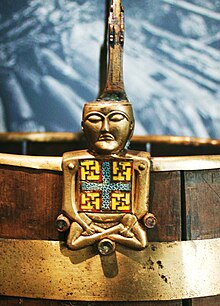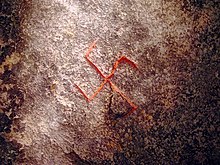




The swastika design is known from artefacts of various cultures since the Neolithic, and it recurs with some frequency on artefacts dated to the Germanic Iron Age, i.e. the Migration period to Viking Age period in Scandinavia, including the Vendel era in Sweden, attested from as early as the 3rd century in Elder Futhark inscriptions and as late as the 9th century on Viking Age image stones.
In older literature, the symbol is known variously as gammadion, fylfot, crux gothica, flanged thwarts, or angled cross.[1] English use of the Sanskritism swastika for the symbol dates to the 1870s, at first in the context of Hindu and Buddhist traditions, but from the 1890s also in cross-cultural comparison.[2]
Examples include a 2nd-century funerary urn of the Przeworsk culture, Poland, the 3rd century Værløse Fibula from Zealand, Denmark, the Gothic spearhead from Brest-Litovsk, Belarus, the 9th century Snoldelev Stone from Ramsø, Denmark, and numerous Migration Period bracteates. The swastika is drawn either left-facing or right-facing, sometimes with "feet" attached to its four legs.[3] Medallions and bracteates featuring swastikas were issued in Central Europe of late antiquity by the Etruscans[citation needed].
The symbol is closely related to the triskele, a symbol of three-fold rotational symmetry, which occurs on artefacts of the same period. When considered as a four-fold rotational symmetrical analogue of the triskele, the symbol is sometimes also referred to as tetraskele.
The swastika symbol in the Germanic Iron Age has been interpreted as having a sacral meaning, associated with either Odin or Thor,[1] but the Indoeuropean tradition associates the four-fold swastika with solar deities and deities preceding Thor are rather associated with three-fold or more often six-fold symbology.
- ^ a b George Stephens, The Runic Hall in the Danish Old-Northern Museum, Michaelsen and Tillge (1868). "[the Snodelev stone] is also remarkable in another way. Above the runes, on the left, are 3 Horns in the shape of a triskele, here doubtless the mark of thor. On the right side is the Flanged Thwarts, or pre-Christian 4-angled cross, here doubtless the mark of woden."
- ^ e.g. Smithsonian Institution annual report, 1896, p. 796.
- ^ Olaf Olsen; Ebbe Klovedal Reich; Klaus Rifbjerg; et al. (1990). Oldtidens Ansigt: Faces of the Past. Kongelige Nordiske oldskriftselskab. p. 148. ISBN 978-8774682745.
